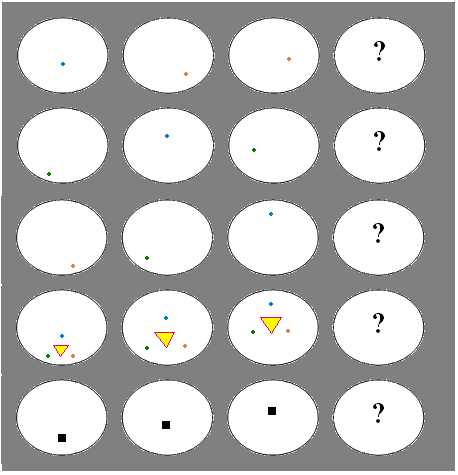3. IQ data set
3.a) Available statistical IQ data set
3.a.1 Young Adulthood Study
The current statistical research uses the IQ data set contained in the Young Adulthood Study: 1939-1967 [made accessible in 1979 on electronic files]. The data set collected by Virginia Crandall and made available through an archive at the Henry A. Murray Research Center of The Radcliffe Institute for Advanced Study, Harvard University, Cambridge, Massachusetts [Producer and Distributor]
The collection of longitudinal data contains the variables needed for the model: those relative to the intelligence quotients (IQ) of parents and their corresponding children. Also, data reliability is another characteristic.
After a preliminary analysis of the available data vectors, the researchers used one variable for the mothers (M) (Otis intelligence test), fathers (F) (Otis test) and children (C4) with their 70 corresponding values. Two more from the children (C1 and C5) with 69 values, and another set of three variables of the children (C2, C3, and C6 with 58, 42, and 64 items respectively) that only helped to create variable X6, the average of the children's six variables.
The info comes from average class white families, with a mean IQ of 110, slightly above regular. For each family, the data source corresponds to the father, the mother, and one child.
(Statistical IQ data set)
| Variables | Name | Reference | Period and Statistical data set | |
| Mothers | M | 186 | d12c66 | T3 mothers IQ data (Otis) |
| Fathers | F | 187 | d12c70 | T3 fathers IQ data (Otis) |
| Children | C1/T1 | 201 | d13cl62 | T1 Stanford-Binet IQ data, score at ages 3, 6, 10-old/10 |
| C2 | 217 | d14cl62 | T2 Stanford-Binet IQ data, score at ages 3, 6, 10-old/10 | |
| C3 | 233 | d15cl62 | T3 Stanford-Binet IQ data, score at ages 3, 6, 10-old/10 | |
| C4/T4 | 185 | d12c62 | T4 IQ data at age 12 | |
| C5/WB | 273 | d18c30 | T4 Wechsler-Bellevue IQ data, @ 13 yrs, perf | |
| C6 | 318 | d20c62 | Primary Mental Abilities-ttl (17-18 yrs.) | |
| C7 | 279 | d18c54 | T4 Wechsler-Bellevue IQ data, recent perf | |
| X3 | = (C1+C4+C5) / 3 | |||
| X6 | = (C1+C2+C3+ C4+C5+C6) / 6 | |||
| T1-d | = C1 smoothed tails, 10% of X6 | |||
3.a.2. Limitations of the statistical data set
-
The sample sizes
The limitation of the sample size could become serious; although the families are 70 (n=70) (Otis IQ test of mothers and fathers and one of the children) when analyzing by groups, there are only seven with a sample size of 10 families each one.
Logic and correlation 
Nevertheless, there is grouping for values of 2, 3, 4, 5, 6, 7, 8, 9, and 10. In addition, different variables act when changing the criteria of the order the 70 values.
Consequently, as shown in the following sections, the number of studied variables increases by more than 50. The treatment of information is in detail in the surprising results section of the Social Model.
Then, the model becomes very sensitive to small data variability in the groups.
The diverse variables suppose views on the same statistical data; in other words, they will simultaneously provide estimations of the correlations in several dimensions.
The sensitivity of the Social Model is the strongest point of the model: the suitable adjustments obtained are very significant regarding the goodness-of-fit of the model's structure, mainly because there is not any modification of the original variables, giving total statistical data reliability.
The strength of the analysis performed allowed attaining the initial objectives and much more.
Data set quality
The test types or methods of IQ evaluation are diverse, as shown in the previous table of the selected variables.
The values considered extreme should go out of the model.
There is only one statistical data set for the parents' IQ and several sets for the children.
Even so, these limitations reinforce the results since with more precise info would be a higher correlation between variables.
The relatively homogenous sample will also work against the study's goal because it is harder to discriminate between the study's values. Therefore, with a diverse sample, the conclusions would be more pertinent.
Temporary stability of intellectual ability
The IQs of children belong to different years. Without having reached a definite idea, it is fair to say that the steadiness of the data set is compatible with the observed values in the model's simulation.
